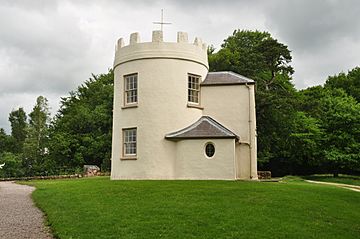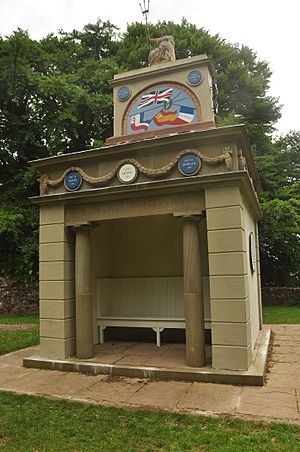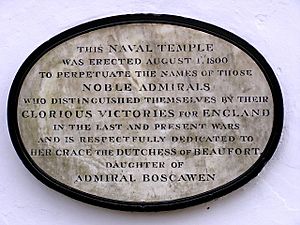The Kymin facts for kids
Quick facts for kids The Kymin |
|
|---|---|

The Round House at the Kymin, Monmouth, Wales
|
|
| Highest point | |
| Geography | |
| Location | Monmouth, Wales |
|
Listed Building – Grade II*
|
|
| Official name | The Kymin Roundhouse |
| Designated | 27 June 1952 |
| Reference no. | 2222 |
|
Listed Building – Grade II
|
|
| Official name | The Naval Temple with surrounding wall |
| Designated | 27 June 1952 |
| Reference no. | 2221 |
| Official name | The Kymin |
| Designated | 1 February 2022 |
| Reference no. | PGW(Gt)5(MON) |
| Listing | Grade II |
The Kymin, also known as Welsh: Cae-y-Maen in Welsh, is a cool hill that looks over the town of Monmouth in Wales. It's about a mile east of Monmouth, near the River Wye. The hill is also close to the border with England and the Forest of Dean.
The top of the hill is about 800 feet (240 meters) high. It's famous for two old buildings: the Roundhouse and the Naval Temple. These were built between 1794 and 1800. The Kymin is a special place listed on the Cadw/ICOMOS Register of Parks and Gardens of Special Historic Interest in Wales. It's also part of an Area of Outstanding Natural Beauty (AONB). The National Trust owns and takes care of the site.
Contents
The Roundhouse: A Club's Meeting Place
The Roundhouse is one of the unique buildings at the top of The Kymin. It has an interesting history and a special design.
History of the Roundhouse
The Roundhouse was built by a group of gentlemen from Monmouth. They called themselves the Monmouth Picnic Club or Kymin Club. These men met every week to have dinner and spend time together. They wanted a building where they could meet, eat, and stay dry in bad weather.
Construction started in 1794. The local landowner, the Duke of Beaufort, helped fund the building. Many important people, including Members of Parliament, also donated money. The building was finished in just two years.
From the Roundhouse, you could see amazing views. An old book from 1807 said you could see ten different counties from the building! These included Gloucestershire, Monmouthshire, Glamorganshire, Breconshire, Montgomeryshire, Worcestershire, Herefordshire, Radnorshire, Shropshire, and Somerset. A special telescope was even placed in the upper room to help people see far away.
Roundhouse: What It Looks Like
The Roundhouse is a white, round tower with two floors. It has a crenellated roof, which means it looks like the top of a castle wall. It's a bit like a folly, which is a building made for decoration.
The club members designed the building for their meetings. The ground floor had kitchens, and the top floor was a large room for banquets and parties. The building was fixed up in the early 1900s. Today, it is a Grade II* listed building, which means it's a very important historic building.
The Naval Temple is another important monument on The Kymin. It was built to remember brave naval leaders.
The Kymin Club built the Naval Temple in 1800. They wanted to celebrate a big British naval victory called the Battle of the Nile, which happened in 1798. The temple also honored sixteen Royal Navy Admirals who had won other important sea battles around the world.
The Duchess of Beaufort officially opened the temple. Her father, Admiral Boscawen, was one of the admirals honored there. A very famous naval hero, Admiral Nelson, visited Monmouth in 1802. He came with Lady Hamilton and her husband, Sir William Hamilton.
Nelson visited the Naval Temple and the Roundhouse. He had breakfast there and loved the views. He was very impressed by the Naval Temple. He said it was "the only monument of its kind erected to the Royal Navy in the Kingdom."
Over the years, some parts of the temple were lost, like a statue of Britannia and two paintings. But the temple has been restored several times. The most recent restoration was in 2012, after a storm. This brought back the Britannia statue, the paintings, and the gates.
The Naval Temple has a classical design. It has two porticos (porches) with Doric columns. On top, there is a bronze statue of Britannia, who represents Great Britain.
The temple is square, and each side has four round plaques. These plaques name the admirals and the famous victories they achieved. The temple is a Grade II listed building, meaning it's an important historic site.
Here are some of the admirals honored at the temple:
- Vice Admiral Charles Thompson
- Rear Admiral Adam Duncan
- Vice Admiral Edward Boscawen
- Admiral Samuel Hood
- Admiral Howe
- Admiral John Warren
- Admiral John Gell
- Admiral Lord Nelson
- Admiral of the Fleet John Jervis
- Vice Admiral George Rodney
- Admiral Hawke
- Vice Admiral Sir Alexander Hood
- Vice-Admiral William Cornwallis
- Admiral Hyde Parker
- Admiral George Elphinstone
- Admiral Andrew Mitchell
Visiting The Kymin Today
The Kymin is a great place to visit! You can get there by a winding road that goes up from the A4136 road. This road connects Monmouth to the Forest of Dean.
The National Trust manages and protects the area. There's a car park near the top, and it's an easy walk to both the Naval Temple and the Roundhouse. On a clear day, the views from the Kymin are truly amazing. The site is listed as Grade II on the Cadw/ICOMOS Register of Parks and Gardens of Special Historic Interest in Wales.
If you like running, you might be interested in the Kymin Dash. It's a cross country running race held every year. The course is about 7 miles long and goes around the town, up and down the Kymin.





